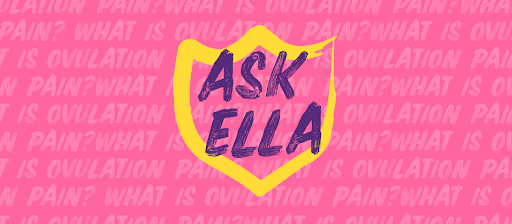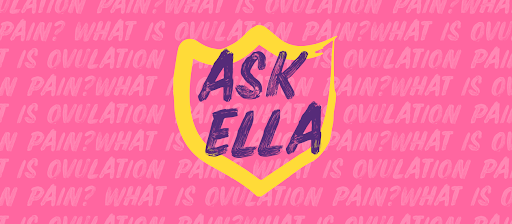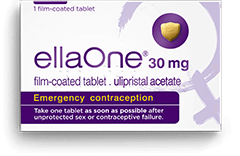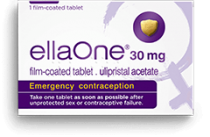What is ovulation pain?
Ovulation pain is a term that describes the discomfort some people feel when they ovulate. Ovulation is where an egg is released from one of the ovaries around half way through your menstrual cycle, although the exact time of ovulation varies from person to person and from month to month.
When you ovulate, the egg is released into the fallopian tubes where it moves towards the uterus. If the egg comes into contact with sperm during its journey through the fallopian tubes, the egg and sperm may fuse. The egg lives for around 12-24 hours after it is released, after which it is either fertilised by a sperm or dissolves back into the body.
“Ovulation pain, often referred to as ‘mittelschmerz in German,’ is a sensation or discomfort that some people with female reproductive anatomy of reproductive age may encounter during their menstrual cycle,” says Rhiannon John, Sexologist at Bedbible. “It occurs around the time of ovulation, which is when an ovary releases an egg in the middle of the menstrual cycle.”
Ovulation pain is often mild and nothing to be concerned about, but you should see a doctor it becomes very painful and/or if it is accompanied by other symptoms .
Symptoms of ovulation pain
“During ovulation, one of the ovaries releases an egg, which then travels down the fallopian tube, potentially awaiting fertilisation,” says Rhiannon John. “It’s worth noting that not everyone with ovaries experiences ovulation pain, and for some it can be a subtle sensation, while others may find it more noticeable. This discomfort is generally felt on one side of the lower abdomen, corresponding to the ovary releasing the egg. The sensation can range from a mild twinge or flutter to a sharper, cramp-like feeling, and its duration can vary from person to person, lasting anywhere from a few minutes to a few hours.”
Ovulation pain can vary in intensity and duration, but it usually feels like a dull ache or sharp twinge in the lower abdomen or pelvis. It typically occurs about 14 days before the next period, and can be short lived or last for a few hours. Some people may also experience:
-
- Light vaginal bleeding or discharge during ovulation, which may be pink, red, or brown in colour
- Increased libido, cervical mucus, or basal body temperature
- Breast tenderness, mood swings, or headaches
Is it normal to bleed during ovulation?
“Yes, it can be normal to experience light vaginal bleeding or spotting during ovulation,” says Rhiannon John. “This is known as ‘ovulation bleeding’. It occurs in some people and is usually harmless. The bleeding is often minimal and short-lived.”
Ovulation bleeding tends to be spotting (less frequent and not heavy) and should only last for a day or two. It is caused by sudden fluctuations between the hormones oestrogen and progesterone, as oestrogen levels fall after ovulation and progesterone rises.
You should see a doctor if you are concerned about pregnancy, or if you are experiencing heavier bleeding, bleeding that lasts longer than 48 hours, bleeding after sex or spotting multiple times during your cycle outside of your period.
Is ovulation pain normal?
Ovulation pain is normal for some people and not a cause for concern. It does not affect fertility or indicate any health problems. However, if the pain is severe, persistent, or accompanied by other symptoms, it may be a sign of an underlying condition that needs medical attention.
“Ovulation pain is considered a normal occurrence for some people,” says Rhiannon John. “However, not everyone experiences it, and the intensity of the pain can vary from person to person.”
What causes ovulation pain?
The exact cause of ovulation pain is not fully understood, but it may be related to:
-
- The swelling and stretching of the ovarian follicle that contains the egg before it ruptures
- The release of blood and fluid from the ruptured follicle into the abdominal cavity and pelvis, which may irritate the lining and cause inflammation
- The contraction of the fallopian tube that transports the egg to the uterus
What is painful ovulation a sign of?
Painful ovulation may be a sign of other conditions that affect the reproductive organs, such as:
-
- Ovarian cysts: Fluid-filled sacs that develop on or inside the ovaries, which may cause pressure, bloating, or twisting
- Endometriosis: A condition where tissue similar to the lining of the uterus grows outside the uterine cavity, which may cause inflammation, scarring, and adhesions
- Pelvic inflammatory disease (PID): An infection of the female reproductive organs, usually caused by sexually transmitted infections (STIs), which may cause fever, discharge, or infertility
- Ectopic pregnancy: A rare but serious condition where a fertilised egg implants outside the uterus, usually in the fallopian tube, which may cause bleeding, rupture, or shock
How to treat ovulation pain
Ovulation pain doesn’t usually require any treatment and should go away on its own. If your ovulation pain is bothering you, you may find the following methods helpful for managing ovulation pain:
-
- Taking over-the-counter painkillers, such as ibuprofen or paracetamol
- Applying heat packs or warm towels to the lower abdomen or back
- Getting enough rest and managing stress
When to seek help for ovulation pain
“In most cases, ovulation pain (mittelschmerz) is not a cause for concern and is a normal part of the menstrual cycle,” says Rhiannon John. “It is not typically associated with underlying medical issues. However, if the pain is severe, recurrent, or accompanied by other concerning symptoms, it’s advisable to consult a healthcare provider to rule out any potential underlying conditions.”
Ovulation pain is usually harmless and short-lived, but it can sometimes be confused with other types of pelvic pain that may need medical attention. You should see your doctor if you have:
-
- Severe or unbearable pain that does not improve with painkillers
- Pain that lasts longer than 48 hours or occurs at other times of your cycle
- Pain that interferes with your daily activities or sex life
- Pain that is accompanied by heavy bleeding, fever, nausea, vomiting, or other symptoms
- Pain that occurs after a recent surgery, injury, or infection in the pelvic area
- Pain that occurs when you are pregnant or trying to conceive
Your doctor may perform a physical examination and order some tests to diagnose the cause of your pain and rule out any serious conditions. These tests may include:
-
- Pelvic ultrasound: A scan that uses sound waves to create images of your ovaries and other pelvic organs
- Blood tests: A sample of your blood which will be checked for hormone levels, infection markers, or pregnancy hormones
- Laparoscopy: A minor surgery that involves inserting a thin tube with a camera through a small incision in your abdomen to look inside your pelvis
Ovulation pain is fairly common in people who have periods and is usually mild and nothing to be concerned about, but it can sometimes be a sign of an underlying condition that needs medical attention. If you have any concerns about your ovulation pain or any other pelvic pain, speak to your doctor for advice.
ellaOne® 30mg film-coated tablet contains ulipristal acetate and is indicated for emergency contraception within 120 hours (5 days) of unprotected sexual intercourse or contraceptive failure. Always read the label.




